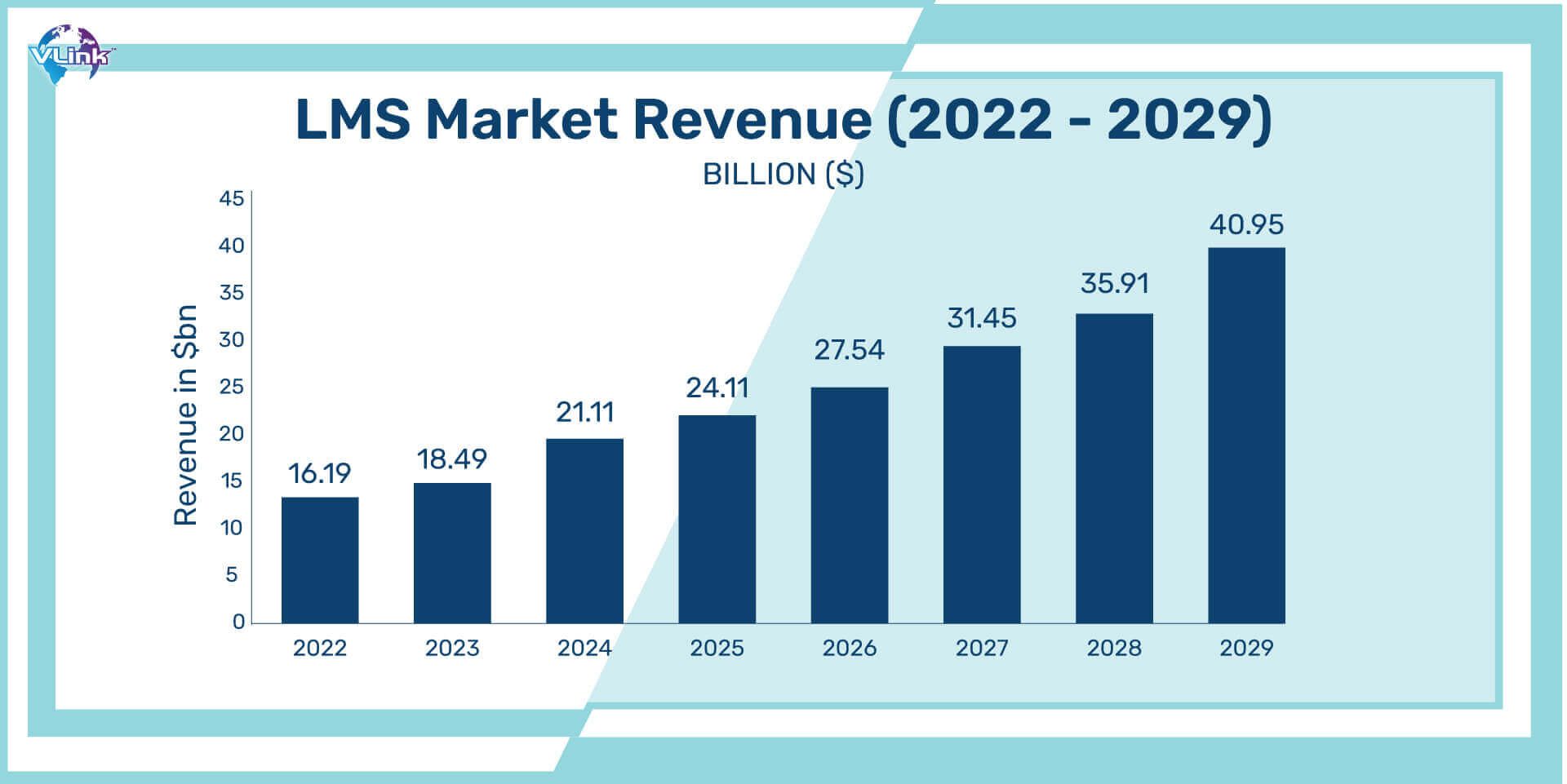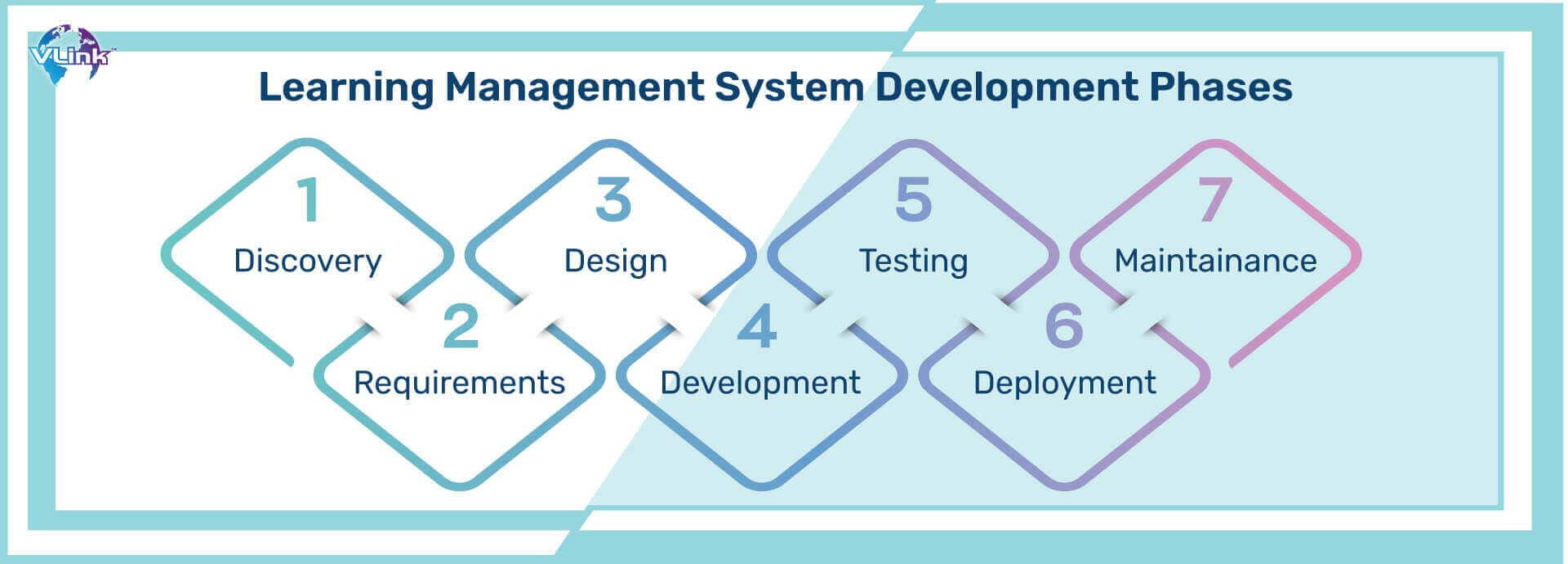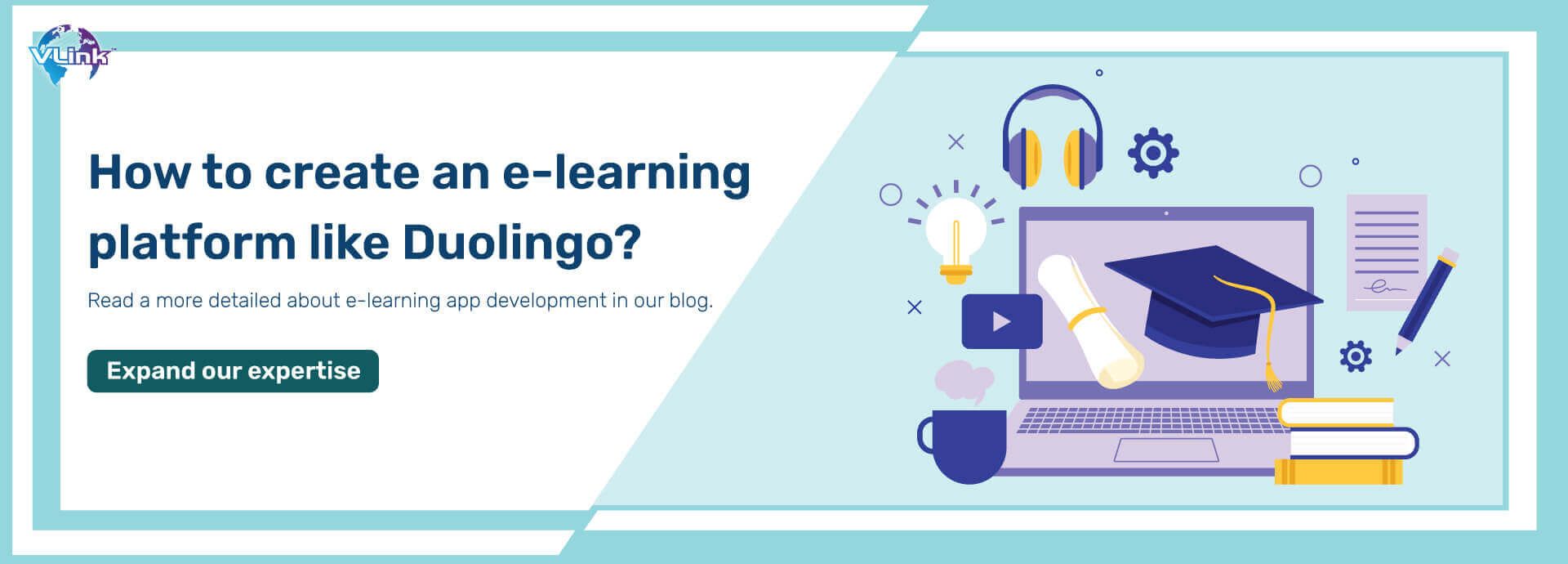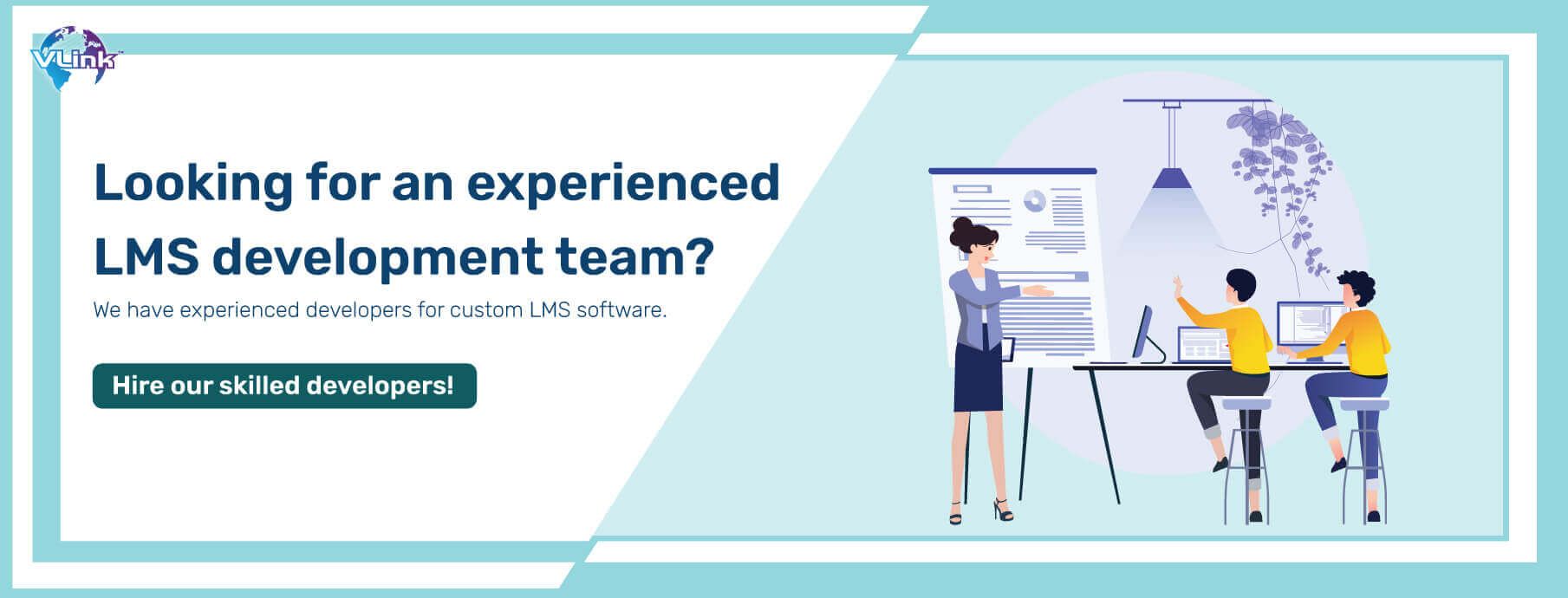It’s a digital era where everything is online. And Edtech software has replaced traditional classes. In 2022, the global online education market was over $300 bn, with LMS constituting close to 50% of this share.
Learning Management System is one of the hottest types of educational portal. The worldwide LMS market is projected to be valued at 2.3X in the next five years – from $18.7Bn to $46.3Bn.

But What is Learning Management System (LMS)?
An online learning management system (LMS) is software designed to facilitate learning. It operates online, enabling users and students to connect regardless of location.
LMS can be implemented in educational institutions to establish virtual classrooms, fostering interaction between teachers and students.
The extensive advantages of LMS have led to its widespread adoption, with numerous governmental and non-governmental organizations either utilizing it or considering its implementation.
So, how to develop an LMS from Scratch with custom functionality?
This blog will help you explore everything about LMS development, from the market overview, features, and tech stacks to costs.
Let’s first start with its statistics:
Learning Management System Market Overview
Here are some statistics on learning management systems, according to research.com:
- The LMS market will reach $28.1 billion by the end of 2025.
- In the US higher education LMS market, Canvas and Blackboard hold a significant share, with a combined dominance of 28%.
- The e-learning market in Latin America is expected to generate $3 billion in revenue by 2023.
- Currently, the estimated number of LMS users is 73.8 million.
- Approximately 87% of active users utilize web based LMS programs.
- 70% of learning and development departments used an LMS for their training programs in 2020. (Statistics)
These numbers clarify why investing in an LMS development solution is worth it.
What is a Type of Learning Management System?
Before starting to build a custom learning management system, let’s look into its types:
- Open-source LMS
- Commercial LMS
- Installed or Hosted LMS
- SaaS LMS
- Integrated LMS
- Non-integrated LMS
A Step-By-Step Guide to Build a Learning Management System from Scratch

Step #1 - Discovery Phase
Research & plan the LMS development.
Validating your app idea is essential to create a successful learning management system. Here are key steps to follow:
- Define the purpose of LMS solutions.
- Identify the main issues of your LMS to resolve.
- Specify the available budget for LMS development.
- Decide the target audience for your project.
- Think about your LMS monetization model, whether freemium or premium.
You must have a detailed plan to have a clear idea of how to create a learning management system.
This phase involves several things you need to consider:
-
Market & Competitor Analysis
-
Scope of work
-
User stories
-
Architecture design
After the discovery stage, you should understand the rough estimate of the Time and costs of the learning management system development process.
Step #2 - Requirement Phase
Define the core features and tech stacks for LMS development.
Key and advanced features are shown in the image below:
Select Right Tech Stack
The proper tech stack is critical for building a stable, smooth-running, secure learning management system. At VLink, we pick a custom tech stack for LMS as per its types and the required functionality.
Here are several tech stacks that a learning management system development include:
Popular Tech Stacks & framework for Backend
Django, Rails, Node.js
Popular Tech Stacks & framework for Frontend
Vue.js & React.js
Popular Tech Stacks & Framework for Databases
PostgreSQL or MySQL
Hosting
Secure, productivity & pricing, Amazon Web Services are the perfect choice for cloud-based learning management system development.
Step #3 - Design Phase
Now that you have decided on the LMS development stack and features, it’s Time to move towards a learning management system’s specification. You must create a schematic representation of the final LMS budget estimation at this stage.
After deciding on this platform’s specifications, designers conceptualize the UI/UX of the learning management system. Then they will start with building LMS mockups and wireframes for complicated architecture. Once the design is finalized, developers turn it into a functional product.
Step #4 - Development Phase

Start with the MVP Launch of the LMS.
The next step is dedicated to MVP development. A minimum viable product is a version of your product with basic & advanced features to meet customers’ needs.
Launching the MVP version of LMS allows for gathering feedback at early development stages and improving the final product. Separate activities between developers set deadlines and let project managers handle the process.
Step #5 - Testing Phase
Subjecting LMS features and functionalities to comprehensive testing is essential to ensure their smooth operation. QA professionals play a vital role in ensuring the highest level of product quality and reliability.
Here are the main requirements for QA:
-
Maintaining a thorough QA checklist to verify the proper functioning of designs, content, and assessment resources.
-
Conducting checks on platform and device compatibility for the LMS website.
-
Inspecting each functionality in detail.
-
Performing regression testing after each sprint.
Step #6 - Deployment Phase
Now that you have collected all the essential information and metrics regarding the MVP of your learning management system, the next step is to incorporate the valuable feedback received. It will ultimately enhance the user experience of the product.
- The process of release management cycle:
- Request for changes to new features
- Release planning and design
- Software Build
- Review
- Test
- Deployment
- Support
- Issue Reporting and Collection
Step #7 - Maintenance Phase
The code is deployed promptly once the testing confirms that all features meet the client's requirements. We adhere to the Systems Development Life Cycle (SDLC) methodology to avoid any delays.
Additionally, before the significant milestone, the development team diligently prepares a comprehensive description of the Learning Management System (LMS) features and provides instructions on operating them.
With the completion of the development & deployment phases of the LMS, we offer maintenance services that encompass different aspects.
By continuously monitoring the LMS performance and gathering user feedback, you can request any necessary fixes or changes to enhance its functionality.
Bonus Tips to Create a Successful Learning Management System
Here are a few bonus tips for creating the best LMS:
In-depth third-party integration
A learning management system (LMS) is a versatile platform where instructors can effectively share their expertise to educate their intended audience.
Developing a third-party integration within an LMS necessitates a comprehensive understanding of the LMS itself and the third-party application. Additionally, it requires strong development skills and meticulous attention to detail.
The process begins with clearly defining the integration requirements and selecting the appropriate integration method, followed by the careful deployment of the integration. Each step must be approached with mindfulness and precision.
Support popular multimedia formats
An ideal learning management system should focus on its multifunctional nature, enabling an engaging and versatile educational experience. Both learners and staff need to have the capability to communicate using various multimedia formats, including text, audio, video, and photos.
Single login-all the functionality
Combining the separate portals for students, teachers, and parents into a single learning management system (LMS) is a more efficient approach that avoids unnecessary bandwidth consumption.
By combining all functionalities into one software, we can provide comprehensive insights and support to all stakeholders involved in the learning process.
Customize to meet client’s needs.
Implement customization where necessary, offering educators a dedicated toolkit to enhance their instructional methods. By doing so, we establish an advantageous and personalized learning environment for students while providing adaptive options for teachers.
How Much Does It Cost to Create an LMS from Scratch?
The money it will cost you to build an LMS depends on whether you create it from Scratch or use ready-made SaaS software.
-
LMS basic costs: $40,000 to $400,000+.
-
Simple LMS (Ex. MVP version): $40,000 - $60,000+
-
Medium Complexity LMS platform (sophisticated functionality): $60,000-$150,000+
-
Complex Learning Management System (including advanced features): $150,000-$400,000+
Setup Fees
- Min: $4,000-$7,000
- Up to $25,000
Annual License and Per User Fees
- License Fee: $20,000 annual
- Per User Fee: $2 to $5
Hidden Costs
- Fees for Self-Hosted LMS: $25,000 (One Time)
- Extra Add-on Fees: $99 to $1199 (monthly)
- Hiring an IT Vendor: $4,000 (Monthly)
(Table)Country MVP (One Platform) Complete Product (Basic Functionality) Eastern Europe $150K-$300K $200K–$450K Western Europe $220K–$450K $300K–$650K USA $375K–$750K $500K–$1.5M India $75K–$150K* $100K–$250K*
Here are several factors that affect the cost of developing an LMS.
- Project scope
- Feature complexity
- Third-party integration
- Hosting
- Specific compliance standards
- Multilingual and localization support
- Advanced features
- Scalability
Create an Effective Learning Management System with VLink.
If you want to create LMS from Scratch, nothing can be better than VLink.
We are a outsourcing software development company with deep expertise in edTech app development solutions. Our dedicated team of certified software programmers has experience in implementing several advanced LMS features as per clients’ needs.
VLink provides custom LMS consulting and development services to help run training, learning, and development programs in education and business settings.
Here are a few reasons why you should choose VLink to create effective LMS solutions:
- Versatility
- High-performing solutions
- Compliance with EdTech standards
- Experience and expertise
- Rich functionality
Wrapping UP!
If you’re interested in creating your learning management system and want complete control over its features, custom learning management system development is the way to go.
By outsourcing the development team, the risks associated with creating a custom Learning Management System (LMS) can be minimized. It ensures fast delivery of a high-quality product, even with limited resources.
Frequently Asked Questions
The Time required to develop an LMS from Scratch can vary significantly based on complexity, features, team size, and development approach. However, it typically takes several months to a year or more to design, develop, test, and deploy a fully functional and robust LMS.
LMS (Learning Management System) provides centralized administration, documentation, tracking, and reporting of educational courses and training programs.
Benefits include easy access to learning materials, streamlined course management, automated assessments, personalized learning paths, and enhanced collaboration and communication among learners and instructors.
An LMS (Learning Management System) is a software application that helps manage, deliver, and track online learning content, whereas an e-learning platform refers to a broader term encompassing various tools and technologies used for online education, including the LMS.
Some popular Learning Management Systems (LMS) in the market were Moodle, Canvas, Blackboard, Schoology, and D2L Brightspace.








